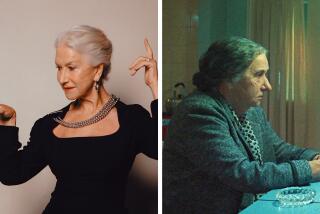Marceau’s Magic: Inspired Details
- Share via
Onstage at the Wiltern Theatre on Saturday, Marcel Marceau is performing “The Mask Maker,” a solo or mimodrama in which the title character switches from one false face to another with spectacular rapidity. The masks are invisible, of course, but they alter his expression and even his stance so completely that he seems to be trying on a whole gallery of identities.
Happy, Sad, Happy, Sad--the changes alternate with increasing speed until the virtuosity starts to grow cheap, an empty display leading nowhere. And right then disaster occurs: The mask of a grinning fool won’t come off. The mask maker struggles to remove it, he panics, he pleads, he weeps. But he’s still the grinning fool. Finally, he summons something like suicidal desperation and manages to pry it off, standing drained and fearful as he understands for the first time the power of what he’d exploited so arrogantly, the power of art.
It is that power that separates Marceau from his imitators and makes him at age 74 not merely the greatest star mime of the century but an icon of Western culture. His imitators see mime as nothing more than stylized silent acting and perhaps could match him in the passages from “Bip Travels by Sea” that show his archetypal Everyman character trying to walk on a rolling deck. But carefully observed, lovingly detailed reproductions of the real world are just a point of departure in Marceau’s greatest pieces--and that’s where his imitators stop.
In “The Trial,” he goes beyond merely delivering deft character sketches of opposing attorneys, a defendant and a judge to become something larger than life: the scales of justice. And he carries the narrative as far as the gallows. In “The Bird Keeper,” he uses his hands to create meticulously crafted images of soft, fluttering wings but ends with a visionary, whole-body statement of something resembling a giant eagle but essentially a generic abstraction: bird-ness in all its mystery, grandeur and untamed capacity for violence. In “The Hands,” he composes pure movement poetry by shaping each hand into a distinctive kinetic and even moral force and then uniting the two in a gesture of prayer.
At such moments, Marceau looks magically weightless, shadowless, part of the same dimension as those invisible objects and people in his pieces. And when he stretches out his arms in a concluding statement of wonder and acceptance several times during the evening, he seems to fill up with light and become nearly transparent. After half a century of such epiphanies, no wonder malls and parks teem with white-faced wusses invoking “here’s-a-flower, I-love-you” platitudes.
But they’re missing the point. Marceau commands all the resources of a complex European tradition stretching back to the Renaissance, a tradition that began in slapstick street theater and mutated to sad-clown sentimentality but eventually became profoundly metaphysical. His mime teaches us that our bodies are our world--and that there is no other. Everything else is simply manipulated perception or sheer illusion. In “The Public Garden,” he pretends to walk a dog and just by watching the dog makes us laugh at what the dog is doing. His magic is potent: We actually see that dog and feel liberated by the act of momentarily entering another reality, the reality we’ve created ourselves in collaboration with a master artist.
The context can be sublimely silly (the Chaplinesque tango with an enormous partner in “Bip and the Dating Service”), or it can be deeply philosophical (the time-lapse life journey of “Youth, Maturity, Old Age and Death”). But it calls from us a willingness to believe in art conjured out of thin air, indeed a primal craving for exactly that kind of art. With unfailing gentleness, refinement and, of course, plenty of disarming whimsy, Marcel Marceau makes the human body into a theater of wonders, the only theater any of us will ever need.
More to Read
The biggest entertainment stories
Get our big stories about Hollywood, film, television, music, arts, culture and more right in your inbox as soon as they publish.
You may occasionally receive promotional content from the Los Angeles Times.










